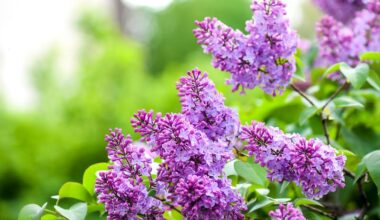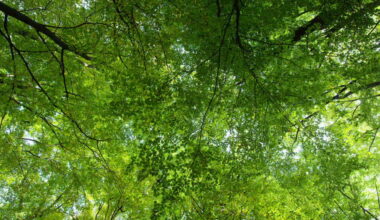You’ve already heard of ground cover and shade perennials, but you may not be familiar with the subject… Don’t panic, we’re here for you.
Ground cover perennials are ideal for flowering a garden corner that is a little poor or overgrown with weeds. Shade perennials on the other hand are very useful to set up a corner of garden deprived of sunshine. Because yes, it is important to keep in mind that some plants love shade.
Contents
4 plants to put around your fruit trees
1. The ornamental apple tree
Cross-pollination improves the fruiting of apple trees. If, for space reasons, you can’t add a few juicy varieties that are known to be good pollinators such as ‘Queen of Queens’ and ‘Golden Delicious’, think of ornamental apple trees like this ‘Red Jewel’, the small glossy apples. The cultivars ‘Evereste’ and ‘Golden Hornet’ are also interesting.
Invite the apple trees to the ornamental garden! They deserve to be showcased in any shape, free or trellised. At the end of the summer, the combination of the apple tree in fruit and the asters is most successful. Thus dispersed in the garden, it will also be easier to associate some ornamental apple trees with them. The latter are rather to be installed near the house to appreciate the spectacular flowering in spring and the small apples in winter.
2. Nasturtium
Nasturtium is known for its propensity to concentrate black aphid populations; less is known about its beneficial effects on apple trees. However, they are multiple. Its exuberant vegetation covers the soil well. Planted at the foot of the tree, this annual effectively limits the development of weeds. It serves as a shelter for many other insects, starting with the predators of aphids but also those of the codling moth caterpillar, the apple worm.
In April-May, sow the nasturtium seeds at the base of the apple trees. In the city, use this annual in pots and planters. It can be easily reseeded.
3. The alysses
Lobularia maritima has no equivalent to attract small wasps, bees, bumblebees and spiders. Its perfume testifies to its richness in nectar. Like the majority of annual plants, despite a short life cycle, it allows the installation of an ecosystem in record time. The zinnia (top on the picture) has the same advantages.
Take care of flower beds and flowering meadows as soon as possible, as soon as the big frosts are over. An early sowing will advance the flowering period and protect fruit trees before pests exert too much pressure.
4. Horseradish
This perennial plant of the Brassicaceae family is known for its protective effect against cryptogamic diseases of fruit trees, i.e. those resulting from fungal attacks. Armoracia rusticana, the horseradish, would act against moniliasis, powdery mildew and peach blister also. Chives planted at the foot of the apple tree have the same effects.
Because of its important rooting, it is easier to plant horseradish around or between trees rather than at their base.
Sow a flower meadow at the foot of your fruit trees
Flowers to improve harvests
To improve harvests, mixtures rich in melliferous plants should be chosen. Although they bloom much later than fruit trees, their flowers provide shelter and food in the off-season for pollinators that, gorged with nectar, reproduce and nest in the orchard.
Once the insect populations are sustainable, they are at work in the spring to pollinate the first cherry and apple blossoms.
To enrich and aerate the soil
To enrich a soil, mixtures composed of leguminous plants will be used, these act directly on the soil. Clover, for example, is capable of fixing nitrogen from the air and storing it in the nodes of its roots. As it travels, it releases this nitrogen little by little and makes the surrounding plants benefit from it.
To aerate a soil and make it more permeable, we will look for herbaceous plants with taproots. Dandelions of course, these have powerful roots that carrot the soil and make it more flexible and more aerated.
Promoting biodiversity in the orchard
In addition to these specific mixtures, the flowered fallow creates a protective environment that promotes biodiversity and helps establish an ecological balance, it covers and protects the soil from erosion and dehydration it is much more nutrient and water efficient than a lawn mowed every week.
In summer, the fruit trees provide protective shade, and it brings nutrients and freshness to the foot of the trees, it is a win/win exchange. Finally, this protective mattress cushions the fall of the fruits, they do not get damaged and therefore, they keep much longer.
How to sow your flowery meadow at the foot of the fruit trees
The implementation of a flowered fallow is simple, sowing is done in spring, during April/May, on a flexible and clean surface. First prepare the soil by cleaning the weeds*, make a light digging on the surface 2 – 4 inches deep and crumble the soil with a rake.
Sow the flower mixture, taking care to scatter the seeds well, then lightly cover the seeds with soil with a rake, compact the soil and water lightly to press the seeds to the ground. Germination is fast, count 1 to 3 weeks, as soon as the seedlings develop, keep the soil cool for 3-4 weeks, after this time, the fallow is self-sustaining and the first flowers bloom.
Planting lavender around fruit trees
Lavender cultivated in small hedges
Planted in rows every 20 inches, lavender forms a small hedge with evergreen foliage over 60 cm high. It protects the vegetables in spring from the cold wind in a microclimate. In summer, it prevents the planted vegetables from drying out. It shades plants sensitive to the sun such as lettuce, chicory and curly endive seedlings.
Lavender repels parasites
The bags of dried flowers embalm the linen cupboards and keep moths away. In the garden, the strong scent of lavender is a repellent against parasites, especially aphids, white flies. You will never see an aphid in lavender. However, a single plant is not enough to be effective. In a vegetable garden, border the lavender alleys.
Lavender is content with little
Mediterranean plant, it tolerates very well temperatures of – 4°F. The lavender does not greedy the vegetable garden because a little is enough for it to develop. It appreciates a poor and arid soil. In a clay vegetable garden, add sand to drain the soil in winter. It is planted in autumn in southern regions and rather in spring elsewhere.
A lavender hedge can be pruned very lightly after flowering with shears, taking care not to cut on dry wood because it would not go back. Some flowers sometimes come back in autumn. The real ball pruning takes place in spring without reaching the dry wood. A second pruning can be considered to stagger its flowering by cutting off the stems when they start to bud.
Summary
It is often believed that letting wild grasses grow at the base of fruit trees is detrimental to their growth and that if they are not cut frequently, all kinds of diseases can spread. On the contrary, it would seem that they have more benefits than disadvantages and if some of them can sometimes give a “neglected” aspect to the garden, many of them have been selected for many years to be used in the composition of fallow land and flowering meadows.
If the natural criterion is important in the garden and especially in the orchard and vegetable garden, the aesthetic aspect also counts. Fallow land and flowery meadows have the advantage of combining aesthetics and ecology, they are precious allies in the fight against pests and/or to improve the harvest while maintaining an attractive flowering. The numerous seed mixtures that flowering fallow land contains enrich the soil, attract pollinators, and even aerate the soil. Each mixture has its own specificities.








